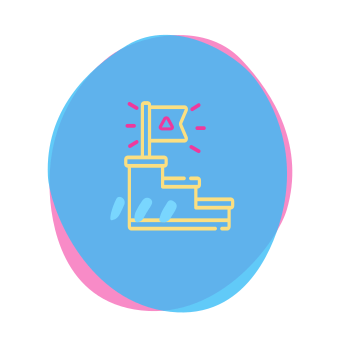


IMPACT LADDER & IMPACT PLAN
The impact tools are helpful for visualizing the logical structure of the project in a clear and straightforward manner.
Stats
Time needed:
2-8 hours
Difficulty level:
Difficult
Materials
Post-It notes, thick pencils, worksheet, impact ladder
Participants
Team members, potentially target group(s) representatives/ partners
Topic
WHY THIS TOOL?
The impact tools enable you to check if the project is successful – i.e., if the desired impact has been achieved – and to examine which activities and conditions lead to this outcome. They also make it possible to divide the impact into various levels: Impact at a societal level – as described in the section on societal impact, each project can only render a small contribution towards this long-term objective – and impact on the target group, which is influenced directly by the project. Thus, the impact ladder forms the basis for the impact plan.
STEPS:
01.
Have your team members sit together and ideally also get a few representatives of/ partners from the target group(s) to join you. Write the numbers 1-7 on DIN A4 paper and stick them one under another to the wall (with 7 at the top and 1 at the bottom). Print out the worksheet with the impact ladder so that you always know which question you answer for each number.
02.
Start with line number 7 (Impact) — this question is one of the most difficult to answer. Ideally you have already completed a separate workshop on this topic to find out what societal problem you aim to solve and what a scenario in which you are no longer needed, i.e. in which you have successfully completed your work, would look like.
03.
Now turn your attention to lines 4, 5 and 6 and formulate impact objectives (Outcomes) for each target group. If you are still unsure who your target groups are, first do the target group matrix exercise. Important: Create a separate impact ladder for each target group to prevent excessive complexity.
The best way to formulate impact objectives is to assume that the impact has already occurred for the respective target group. Also try to be as specific and precise as possible so that it is clearly recognizable when an impact objective has been reached. You can follow the sequence or simply write down your impact objectives for the respective target group on Post-It notes and then assign them to the respective levels. Then sort out and prioritize your objectives. You will notice how at the end you only have a small number of remaining objectives that are clearly distinct from one another, but still build on one another from level to level.
04.
Finally, examine levels 1-3, enter your activities (Outputs) and analyze critically if you can currently reach the objectives at all three levels with these activities. If the answer is yes, then this is great! If not, then the impact ladder now gives you a foundation that you can use to assess how to adjust your activities or your objectives so that you can be successful in the future!
05.
And, if you wish to further develop the whole thing into a full-fledged impact plan, just supplement the model with the resources (Inputs) that you need to implement the activities. You can see an example of what it looks like here: PHINEO Impact Plan.
MORE INFORMATION AND TOOLS:
We did not invent the impact ladder ourselves, but find it to be such a valuable tool that we are very pleased to present it to you here. Our friends from PHINEO, the top impact specialists in Germany, built it on the basis of many years of experience and similar, internationally recognized models. Check out their website – PHINEO – to find even more excellent impact tools!
Another great resource that we like to gain inspiration from is ideo.org. There you will find slightly modified versions of the impact ladder and impact plan. They are referred to as “impact ladder” and “theory of change” there.